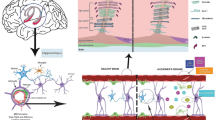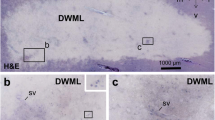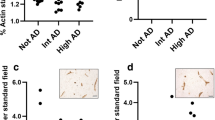Abstract
Previously we have employed antibodies to the tight junction (TJ)-associated proteins ZO-1 and occludin to describe endothelial tight junction abnormalities, in lesional and normal appearing white matter, in primary and secondary progressive multiple sclerosis (MS). This work is extended here by use of antibodies to the independent TJ-specific proteins and junctional adhesion molecule A & B (JAM-A, JAM-B). We have also assessed the expression in MS of β-catenin, a protein specific to the TJ-associated adherens junction. Immunocytochemistry and semiquantitative confocal microscopy for JAM-A and β-catenin was performed on snap-frozen sections from MS cases (n = 11) and controls (n = 6). Data on 1,443 blood vessels was acquired from active lesions (n = 13), inactive lesions (n = 13), NAWM (n = 20) and control white matter (n = 13). In MS abnormal JAM-A expression was found in active (46%) and inactive lesions (21%), comparable to previous data using ZO-1. However, a lower level of TJ abnormality was found in MS NAWM using JAM-A (3%) compared to ZO-1 (13%). JAM-B was strongly expressed on a small number of large blood vessels in control and MS tissues but at too low a level for quantitative analysis. By comparison with the high levels of abnormality observed with the TJ proteins, the adherens junction protein β-catenin was normally expressed in all MS and control tissue categories. These results confirm, by use of the independent marker JAM-A, that TJ abnormalities are most frequent in active white matter lesions. Altered expression of JAM-A, in addition to affecting junctional tightness may also both reflect and affect leukocyte trafficking, with implications for immune status within the diseased CNS. Conversely, the adherens junction component of the TJ, as indicated by β-catenin expression is normally expressed in all MS and control tissue categories.



Similar content being viewed by others
References
Abbott NJ (2000) Inflammatory mediators and modulation of blood–brain barrier permeability. Cell Mol Neurobiol 20:131–147
Aurrand-Lions M, Duncan L, Ballestrem C, Imhof BA (2001) JAM-2, a novel immunoglobulin superfamily molecule, expressed by endothelial and lymphatic cells. J Biol Chem 276:2733–2741
Ballabh P, Furong HU, Kumarasiri M, Braun A, Nedergaard M (2005) Development of tight junction molecules in blood vessels of germinal matrix, cerebral cortex and white matter. Pediatr Res 58:791–798
Barton ES, Forrest JC, Connolly JL, Chappell JD, Liu Y, Schnell FJ, Nusrat A, Parkos CA, Dermody TS (2001) Junction adhesion molecule is a receptor for reovirus. Cell 104:441–451
Bazzoni G (2000) Interaction of junctional adhesion molecule with the tight junction components ZO-1, cingulin, and occludin. J Biol Chem 275:20520–20526
Bo L, Peterson JW, Mork S, Hoffman PA, Gallatin WM, Ransohoff RM, Trapp BD (1996) Distribution of immunoglobulin superfamily members ICAM-1, -2, -3, and the beta 2 integrin LFA-1 in multiple sclerosis lesions. J Neuropathol Exp Neurol 55:1060–1072
Bolton SJ, Anthony DC, Perry VH (1998) Loss of the tight junction proteins occludin and zonula occludens-1 from the cerebral vascular endothelium during neutrophill-induced blood–brain barrier breakdown in vivo. Neuroscience 86:1245–1257
Braga VM, Del Maschio A, Machesky L, Dejana E (1999) Regulation of cadherin function by Rho and Rac: modulation by junction maturation and cellular context. Mol Biol Cell 10:9–22
Carman CV, Springer TA (2004) A transmigratory cup in leukocyte diapedesis both through individual vascular endothelial cells and between them. J Cell Biol 167:377–388
Dore-Duffy P, Washington R, Dragovic L (1993) Expression of endothelial cell activation antigens in microvessels from patients with multiple sclerosis. Adv Exp Med Biol 331:243–248
Ebnet K, Suzuki A, Ohno S, Vestweber D (2004) Junctional adhesion molecules (JAMs): more molecules with dual functions. J Cell Sci 117:19–29
Estes ML, Rudick RA, Barnett GH, Ransohoff RM (1990) Stereotactic biopsy of an active multiple sclerosis lesion. Immunocytochemical analysis and neuropathologic correlation with magnetic resonance imaging. Arch Neurol 47:1299–1303
Filippi M, Tortorella C, Bozzali M (1999) Normal-appearing white matter changes in multiple sclerosis: the contribution of magnetic resonance techniques. Mult Scler 5:273–282
Furuse M, Sasaki H, Fujimoto K, Tsukita S (1998). A single gene product, claudin-1 or -2 reconstitutes tight junction strands and recruits occluding in fibroblasts. J Cell Biol 143:391–401
Girard J-P, Springer TA (1995) High endothelial venules: specialized endothelium for lymphocyte migration ismmunol. Today 16:449–457
Greenberg DA, Jin K (2005) From angiogenesis to neuropathology. Nature 438:954–959
Hawkins CP, Mackenzie F, Tofts P, du Boulay EP McDonald WI (1991) Patterns of blood–brain barrier breakdown in inflammatory demyelination. Brain 114:801–810
Hogg N, Laschinger M, Giles K, McDowall A (2003) T-cell integrins: more than just sticking points. J Cell Sci 116:4695–4705
Ilyas M, Tomlinson IP (1997) The interaction of APC, E-cadherin and beta-catenin in tumour development and progression. J Pathol 182:128–137
Ilyas M, Tomlinson IP, Rowan A, Pignatelli M, Bodmer WF (1997) Beta-catenin mutations in cell lines established from human colorectal cancers. Proc Natl Acad Sci USA 94:10330–10334
Itoh M, Sasaki H, Furuse M, Ozaki H, Kita T, Tsukita S (2001) Junctional adhesion molecule (JAM) binds to PAR-3: a possible mechanism for the recruitment of PAR-3 to tight junctions. J Cell Biol 154:491–497
Johnson-Leger CA, Aurrand-Lions M, Beltraminelli N, Fasel N, Imhof BA (2002) Junctional adhesion molecule-2 (JAM-2) promotes lymphocyte transendothelial migration. Blood 100:2479–2486
Kermode AG, Thompson AJ, Tofts P, MacManus DG, Kendall BE, Kingsley DP, Moseley IF, Rudge P, McDonald WI (1990) Breakdown of the blood–brain barrier precedes symptoms and other MRI signs of new lesions in multiple sclerosis. Pathogenetic and clinical implications. Brain 113:1477–1489
Kirk J, Zhou A-L (1996) Viral infection at the blood–brain barrier in multiple sclerosis: an ultrastructural study of tissues from a U.K. regional brain bank. Mult Scler Clin Lab Res 1:242–252
Kirk J, Plumb J, Mirakhur M, McQuaid S (2003) Tight junctional abnormality in multiple sclerosis white matter affects all calibres of vessel and is associated with blood–brain barrier leakage and active demyelination. J Pathol 201:319–327
Kirk S, Frank JA, Karlik S (2004) Angiogenesis in multiple sclerosis: is it good, bad or an epiphenomenon?. J Neurol Sci 217:125–130
Lai M, Hodgson T, Gawne-Cain M, Webb S, MacManus D, McDonald WI, Thompson AJ, Miller DH (1996) A preliminary study into the sensitivity of disease activity detection by serial weekly magnetic resonance imaging in multiple sclerosis. Neurol Neurosurg Psychiatry 60:339–341
Lassmann H, Wekerle H (2005) The pathology of multiple sclerosis, chapter 12. In: Compston A et al (eds) McAlpine’s multiple sclerosis, 4th edn. Churchill Livingstone, London, pp 557–600
Leech S, Kirk J, Plumb J, McQuaid S (2006) Persistent endothelial abnormalities and blood–brain barrier leak in primary and secondary progressive multiple sclerosis. Neuropathol Appl Neurobiol (in press)
Liang TW, DeMarco RA, Mrsny RJ, Gurney A, Gray A, Hooley J, Aaron HL, Huang A, Klassen T, Tumas DB, Fong S (2000) Characterization of huJAM: evidence for involvement in cell–cell contact and tight junction regulation. Am J Physiol Cell Physiol 279:C1733–C1743
Liang TW, Chiu HH, Gurney A, Sidle A, Tumas DB, Schow P, Foster J, Klassen T, Dennis K, DeMarco RA, Pham T, Frantz G, Fong S (2002) Vascular endothelial-junctional adhesion molecule (VE-JAM)/JAM 2 interacts with T, NK and dendritic cells through JAM-3. J Immunol 168:1618–1626
Liu Y, Nusrat A, Schnell FJ, Reaves TA, Walsh S, Pochet M, Parkos CA (2000) Human junction adhesion molecule regulates the junction resealing in epithelia. J Cell Sci 113:2363–2374
MacIntyre A, Hammond CJ, Little CS, Appelt DM, Balin BJ (2002) Chlamydia pneumoniae infection alters the junctional complex of human brain microvascular endothelial cells. FEMS Microbiol Lett 217:167–172
Makino A, Shimojima M, Miyazawa T, Kato K, Tohya Y, Akashi H (2006) Junctional adhesion molecule 1 is a receptor for feline calicivirus. J Virol 80: 4482–4490
Mandell KJ, Holley GP, Parkos CA, Edelhauser HF (2006) Antibody blockade of junctional adhesion molecule-A in rabbit corneal endothelial tight junctions produces corneal swelling. Invest Ophthalmol Vis Sci 47:2408–2416
Martin-Padura I, Lostaglio S, Schneemann M, Williams L, Romano M, Fruscella P, Panzeri C, Stoppacciaro A, Ruco L, Villa A, Simmons D, Dejana E (1998) Junctional adhesion molecule, a novel member of the immunoglobulin superfamily that distributes at intercellular junctions and modulates monocyte transmigration. J Cell Biol 142:117–127
Matthews PM, Arnold DL (2001) Magnetic resonance imaging of multiple sclerosis: new insights linking pathology to clinical evolution. Curr Opin Neurol 14:279–287
McRae BL, Kennedy MK, Tan LJ, Del Canto MC, Picha KS, Miller SD (1992) Induction of active and adoptive relapsing experimental autoimmune encephalomyelitis (EAE) using an encephalitogenic epitope of proteolipid protein. J Neuroimmunl 38:229–240
Michie SA, Streeter PR, Bolt PA, Butcher EC, Picker LJ (1993) The human peripheral lymph node vascular addressin. An inducible endothelial antigen involved in lymphocyte homing. Am J Pathol 143:1688–1698
Minagar A, AlexanderJS (2003) Blood–brain barrier disruption in multiple sclerosis. Mult Scler 9:540–549
Morrissey SP, Deichmann R, Syha J, Simonis C, Zettl U, Archelos JJ, Jung S, Stodal H, Lassmann H, Toyka KV, Haase A, Hartung HP (1996) Partial inhibition of AT-EAE by an antibody to ICAM-1: clinico-histological and MRI studies. J Neuroimmunol 69:85–93
Naik MU, Mousa SA, Parkos CA, Naik UP (2003) Signaling through JAM-1 and alphavbeta3 is required for the angiogenic action of bFGF: dissociation of the JAM-1 and alphavbeta3 complex. Blood 102:2108–2114
Ostermann G, Weber KS, Zernecke A, Schroder A, Weber C (2002) JAM-1 is a ligand of the beta (2) integrin LFA-1 involved in transendothelial migration of leukocytes. Nat Immunol 3:116–118
Palmeri D, van Zante A, Huang CC, Hemmerich S, Rosen SD (2000) Vascular endothelial junction-associated molecule, a novel member of the immunoglobulin superfamily, is localized to intercellular boundaries of endothelial cells. J Biol Chem 275:19139–19145
Palmeri D, Feng-Rong Z, Rosen SD, Hemmerich S (2004) Differential gene expression profile of human tonsil high endothelial cells: implications for lymphocyte trafficking. J Leukoc Biol 75:910–927
Petty MA, Lo EH (2002) Junctional complexes of the blood–brain barrier: permeability changes in neuroinflammation. Prog Neurobiol 68:311–323
Plumb J, McQuaid S, Mirakhur M, Kirk J (2002) Abnormal endothelial tight junctions in active lesions and normal-appearing white matter in multiple sclerosis. Brain Pathol 12:154–169
Plumb J, Armstrong MA, Mirakhur M, McQuaid S (2003) CD83-positive dendritic cells are present in occasional perivascular cuffs in multiple sclerosis lesions. Mult Scler 9:142–147
Proescholdt MA, Jacobson S, Tresser N, Oldfield EH, Merrill MJ (2003) Vascular endothelial growth factor is expressed in multiple sclerosis plaques and can induce inflammatory lesions in experimental allergic encephalomyelitis. J Neuropathol Exp Neurol 61:914–925
Reese TS, Karnovsky MJ (1967) Fine structural localization of a blood–brain barrier to exogenous peroxidase. J Cell Biol 34:207–217
Rosen SD (1999) Endothelial ligands for l-selectin: from lymphocyte recirculation to allograft rejection. Am J Pathol 155:1013–1020
Schule C, Firth JA (1993) Immunohistochemical localiation of adherens junctions components in blood–brain barrier microvessel of the rat. J Cell Sci 104:773–782
Seidensticker MJ, Behrens J (2000) Biochemical interactions in the Wnt pathway. Biochim Biophys Acta 1495:168–182
Serafini B, Rosicarelli B, Magliozzi R, Stiglano E, Capello E, Mancardi GL, Aloisi F (2006) Dendritic cells in multiple sclerosis lesions: maturation stage, myelin uptake and interaction with proliferating T cells. Neuropathol Exp Neurol 65:124–141
Sharief MK, Noori MA, Ciardi M, Cirelli A, Thompson EJ (1993) Increased levels of circulating ICAM-1 in serum and cerebrospinal fluid of patients with active multiple sclerosis. Correlation with TNF-α and blood brain barrier damage. J Neuroimmunol 43:15–22
Sobocka MB, Sobocki T, Babinski A, Hartwig JH, Li M, Ehrlich YH, Kornecki E (2004) Signaling pathways of the F11 receptor (F11R: a.k.a. JAM-1, JAM-A) in human platelets: F11R dimerization, phosphorylation and complex formation with the integrin GPIIIa. J Recept Signal Transduct Res 24:85–105
Tajouri L, Mellick AS, Ashton KJ, Tannenberg AE, Nagra RM, Tourtellotte WW, Griffiths LR (2003) Quantitative and qualitative changes in gene expression patterns characterize the activity of plaques in multiple sclerosis. Brain Res Mol Brain Res 119:170–183
Werring DJ, Clark CA, Droogan AG, Barker GJ, Miller DH, Thompson AJ (2001) Water diffusion is elevated in widespread regions of normal-appearing white matter in multiple sclerosis and correlates with diffusion in focal lesions. Mult Scler 7:83–89
Williams LA, Martin-Padura I, Dejana E, Hogg N, Simmons DL (1999). Identification and characterisation of human junctional adhesion molecule (JAM). Mol Immunol 36:1175–1188
Wolburg H, Wolburg-Buchholz K, Engelhardt B (2005) Diapedesis of mononuclear cells across cerebral venules during experimental autoimmune encephalomyelitis leaves tight junctions intact. Acta Neuropathol (Berl) 109:181–190
Woodroofe MN, Cuzner ML (1993) Cytokine mRNA expression in inflammatory multiple sclerosis lesions: detection by non-radioactive in situ hybridization. Cytokine 5:583–588
Xu H, Dawson R, Crane IJ, Liversidge J (2005) Leukocyte diapedesis in vivo induces transient loss of tight junction protein at the blood–retina barrier. Invest Ophthalmol Vis Sci 46:2487–2494
Yap AS, Brieher WM, Gumbiner BM (1997) Molecular and functional analysis of cadherin-based adherens junctions. Annu Rev Cell Dev Biol 13:119–146
Zhurinsky J, Shtutman M, Ben-Ze’ev A (2000) Plakoglobin and beta-catenin: protein interactions, regulation and biological roles. J Cell Sci 113:3127–3139
Acknowledgments
Suzie Leech was the recipient of a 1-year post-doctoral fellowship from MS Ireland. The Leica SP2 confocal microscope was purchased with a Wellcome Trust Equipment grant (069411/Z/02/Z). Tissue samples were supplied by the UK Multiple Sclerosis Tissue Bank, funded by the Multiple Sclerosis Society of Great Britain and Northern Ireland.
Author information
Authors and Affiliations
Corresponding author
Rights and permissions
About this article
Cite this article
Padden, M., Leech, S., Craig, B. et al. Differences in expression of junctional adhesion molecule-A and β-catenin in multiple sclerosis brain tissue: increasing evidence for the role of tight junction pathology. Acta Neuropathol 113, 177–186 (2007). https://doi.org/10.1007/s00401-006-0145-x
Received:
Revised:
Accepted:
Published:
Issue Date:
DOI: https://doi.org/10.1007/s00401-006-0145-x




